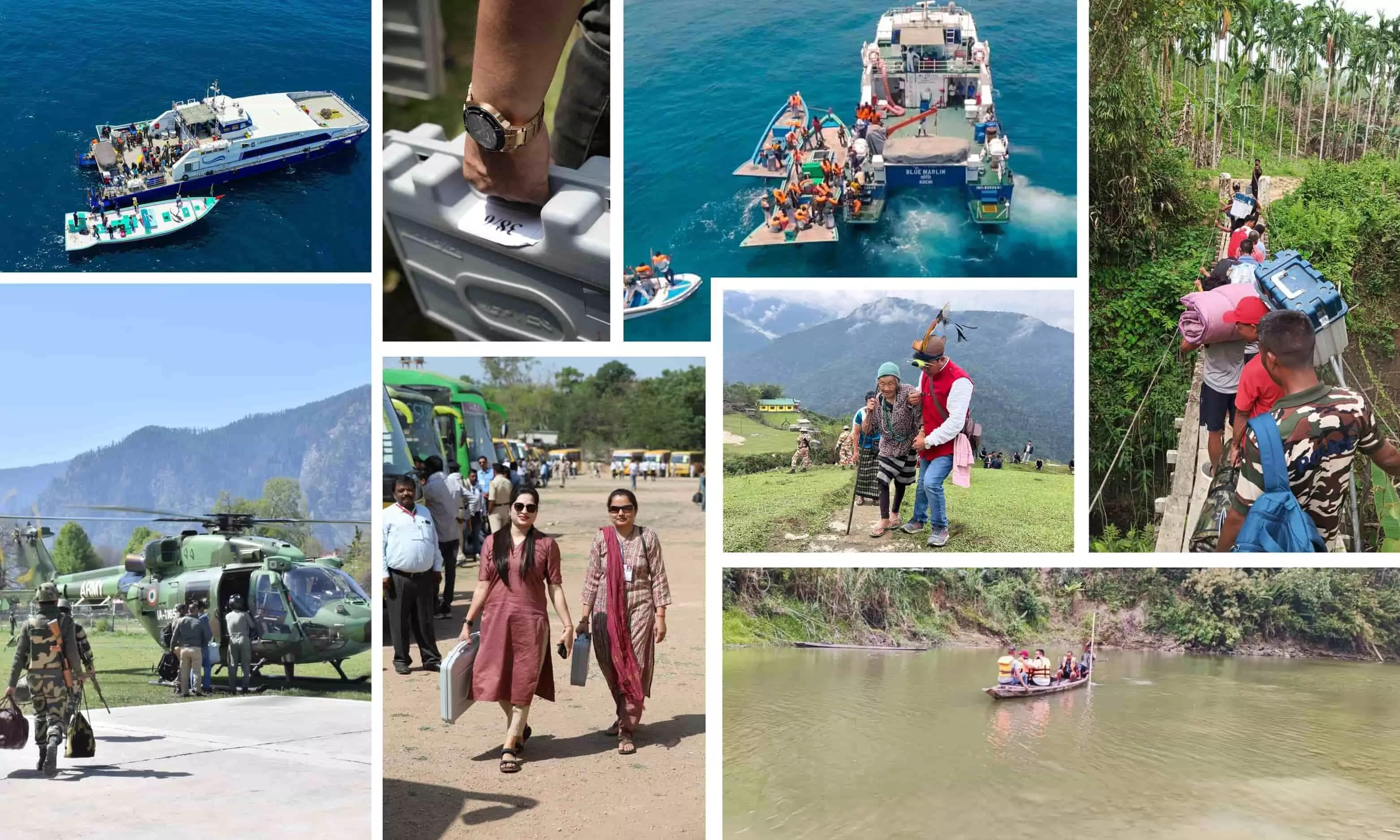
Unravelling the logistics of the world's biggest election
India's democratic spectacle boasts 1 million+ polling booths, 969 million registered voters, and 18 million new voters.

As India begins its highly anticipated general elections 2024, starting today, the logistical machinery behind orchestrating this democratic spectacle is a testament to meticulous planning and coordination. The Election Commission of India (ECI) has set out to facilitate the participation of 969 million registered voters spread across 28 states and eight union territories, with 18 million first-time voters.
The ECI is striving hard to maintain the transparency and efficiency of the electoral process while accommodating such a massive number of voters. It is worth mentioning that 969 million voters constitute more than 10% of the world's population.
It is interesting to note that over 80 nations, spanning from India and the UK to the US, representing over half of the global population, are participating in elections this year. These elections hold significant implications for both democracy and global trade.
Deployment of polling personnel: Ensuring accessibility and efficiency
Conducting elections in India – home to over 1.4 billion people – can be daunting due to the challenges presented by its vast area, accessibility, and diverse terrains. It involves strategically deploying polling personnel to designated locations nationwide, making it a significant logistics milestone. Thousands of officials are mobilised to ensure that every voter can access a polling booth in bustling cities or remote villages.
Source: Election Commission of India
From the treacherous terrains of Arunachal Pradesh's Siang district to the serene islands of Lakshadweep, polling personnel embark on journeys through varied landscapes to uphold the democratic ethos of the nation. This year, ECI has deployed around 15 million to oversee the operation across 1 million polling stations.
In 2019, elections in Arunachal Pradesh, which borders China, significantly demonstrated India's sovereignty over the region. Election officers travelled 300 miles (482 km) over four days across winding mountain roads and river valleys to set up a polling booth for one voter. They also set up a voting booth at 15,256 feet (4,650 metres) in a village in Himachal Pradesh, making it the highest polling station in the world.
Similarly, ECI staff travelled through crocodile-infested mangrove swamps and dense jungles in the remote Andaman and Nicobar Islands to reach polling booths. In Malkangiri district of Odisha, where left-wing Maoist fighters have a presence, polling staff walked 15 km (9 miles) through forests and hills to protect electronic voting machines from the rebels after voting. Intelligence agencies had warned them that using cars could have made them easier targets.
In this year, the first phase of the elections will cover states like Tamil Nadu, Uttar Pradesh, Madhya Pradesh, and Rajasthan, and includes 102 Parliamentary constituencies, as well as elections for the state assemblies of Arunachal Pradesh and Sikkim.
Phase one will see 166.3 million voters, including 84 million males, 82.3 million females, and 11,371 transgender voters. Additionally, over 3.5 million first-time voters are eligible to participate in the electoral process. The Election Commission has registered a total of 1,625 candidates, including 1,491 males and 134 females, vying for various positions.
The electoral process in India poses logistical challenges of ensuring accessibility to polling stations in remote locations. The Election Commission has endeavoured to empower citizens with knowledge and information through extensive awareness campaigns and outreach initiatives, encouraging active participation in the democratic process.
With over 969 million eligible voters, including many first-time electors, the elections serve as a platform for citizens to exercise their democratic rights and shape the nation's future. This year, ECI staff has travelled a total of 1058 km by sea to transport EVMs to all islands of Lakshadweep, including Kavaratti and Agatti.
Technology: Enhancing efficiency and transparency
In the past, the Election Commission of India (ECI) has faced logistical hurdles such as transporting personnel and materials to remote regions and ensuring the safety of voters and election officials, particularly in areas affected by violence and insurgency. The enormity of the task can be seen in the considerable expenses incurred, with logistics alone costing over Rs. 50 billion (USD 598 million) for the 2019 general elections.
However, advancements in operations research (OR) and control tower techniques show promise in optimising election logistics. By utilising mathematical models and real-time data, OR can improve the efficiency of resource allocation, route optimisation, and security deployment. Control tower techniques allow authorities to monitor logistics operations in real time, making it easier to address disruptions promptly.
The United States and the Philippines have successfully implemented OR techniques to optimise election logistics, demonstrating their ability to reduce costs, streamline processes, and improve voter turnout. Technology integration has been critical in modernising India's electoral logistics. Electronic voting machines (EVMs) have replaced traditional paper ballots, while voter-verifiable paper audit trails (VVPATs) ensure transparency and accuracy in the voting process.
Real-time monitoring systems and GPS tracking enable authorities to oversee the transportation of personnel and materials, minimising delays and ensuring timely delivery. Moreover, innovative technologies have enabled greater voter access, particularly in remote regions, through digital platforms and mobile applications.
Overall, the evolution of election logistics in India reflects a commitment to upholding democratic values enshrined in the country's constitution. Furthermore, including innovative technologies has facilitated greater voter accessibility, particularly in remote and marginalised areas. Using digital platforms and mobile applications, election commissions can disseminate information, register voters, and address queries, promoting inclusivity and voter participation.
Enhanced security measures: Safeguarding democratic institutions
Robust security measures have been implemented to ensure the safety and security of polling stations and personnel during the electoral process. To ensure the smooth movement of security forces, ECI has deployed 41 helicopters, 84 special trains, and nearly 100,000 other vehicles. Over 50% of the polling stations will have webcasting, which is live-streaming of the proceedings for authorities to watch.
As per a recent announcement by the ECI, 361 observers have been deployed in their designated areas for the first phase of elections. These observers, comprising 127 general observers, 67 police observers, and 167 expenditure observers, are crucial in maintaining vigilance on behalf of the commission. Moreover, special observers have been dispatched to specific states.
To promptly address any attempts to influence voters, a comprehensive surveillance system has been established which includes 4627 flying squads, 5208 statistical surveillance teams, 2028 video surveillance teams, and 1255 video viewing teams.
Additionally, a total of 1374 inter-state and 162 international border check posts have been set up to monitor the illegal transportation of substances like alcohol, drugs, cash, and gifts. Stringent surveillance measures have also been implemented along sea and air routes.
India's democracy is a resilient and fortified institution. Through meticulous planning, innovative technologies, and unwavering commitment to inclusivity, ECI strives to uphold the democratic ideals enshrined in the constitution. As millions of citizens prepare to cast their votes, the logistics machinery remains poised to facilitate a seamless and efficient electoral process, ensuring that every voter's voice is heard and respected.
India's elections this year will likely be the most expensive in the world. Political parties and candidates are expected to spend over $14.4bn to win over voters, which is twice the amount spent in 2019 and equivalent to the total spending on the US presidential and congressional races in 2020. However, a significant portion of election spending in India is not publicly disclosed, making it easy for candidates to bribe voters with cash, alcohol, or clothes.


